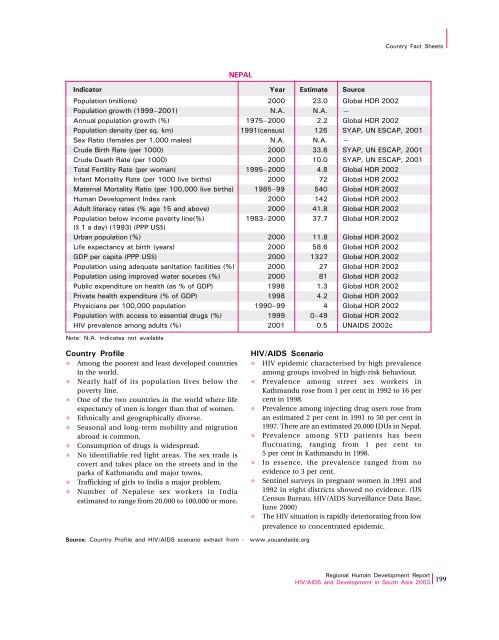Download Report - UNDP Asia-Pacific Regional Centre - United ...
Download Report - UNDP Asia-Pacific Regional Centre - United ...
Download Report - UNDP Asia-Pacific Regional Centre - United ...
You also want an ePaper? Increase the reach of your titles
YUMPU automatically turns print PDFs into web optimized ePapers that Google loves.
Country act SheetsNEPALIndicator Year Estimate SourcePopulation (millions) 2000 23.0 Global HDR 2002Population growth (1999–2001) N.A. N.A. —Annual population growth (%) 1975–2000 2.2 Global HDR 2002Population density (per sq. km) 1991(census) 126 SYAP, UN ESCAP, 2001Sex Ratio (females per 1,000 males) N.A. N.A. —Crude Birth Rate (per 1000) 2000 33.6 SYAP, UN ESCAP, 2001Crude Death Rate (per 1000) 2000 10.0 SYAP, UN ESCAP, 2001Total ertility Rate (per woman) 1995–2000 4.8 Global HDR 2002Infant Mortality Rate (per 1000 live births) 2000 72 Global HDR 2002Maternal Mortality Ratio (per 100,000 live births) 1985–99 540 Global HDR 2002Human Development Index rank 2000 142 Global HDR 2002Adult literacy rates (% age 15 and above) 2000 41.8 Global HDR 2002Population below income poverty line(%) 1983–2000 37.7 Global HDR 2002($ 1 a day) (1993) (PPP US$)Urban population (%) 2000 11.8 Global HDR 2002Life expectancy at birth (years) 2000 58.6 Global HDR 2002GDP per capita (PPP US$) 2000 1327 Global HDR 2002Population using adequate sanitation facilities (%) 2000 27 Global HDR 2002Population using improved water sources (%) 2000 81 Global HDR 2002Public expenditure on health (as % of GDP) 1998 1.3Global HDR 2002Private health expenditure (% of GDP) 1998 4.2 Global HDR 2002Physicians per 100,000 population 1990–99 4 Global HDR 2002Population with access to essential drugs (%) 1999 0–49 Global HDR 2002HIV prevalence among adults (%) 2001 0.5 UNAIDS 2002cNote: N.A. indicates not availableCountry Profilel Among the poorest and least developed countriesin the world.l Nearly half of its population lives below thepoverty line.l One of the two countries in the world where lifeexpectancy of men is longer than that of women.l Ethnically and geographically diverse.l Seasonal and long-term mobility and migrationabroad is common.l Consumption of drugs is widespread.l No identifiable red light areas. The sex trade iscovert and takes place on the streets and in theparks of Kathmandu and major towns.l Trafficking of girls to India a major problem.l Number of Nepalese sex workers in Indiaestimated to range from 20,000 to 100,000 or more.HIV/AIDS Scenariol HIV epidemic characterised by high prevalenceamong groups involved in high-risk behaviour.l Prevalence among street sex workers inKathmandu rose from 1 per cent in 1992 to 16 percent in 1998.l Prevalence among injecting drug users rose froman estimated 2 per cent in 1991 to 50 per cent in1997. There are an estimated 20,000 IDUs in Nepal.l Prevalence among STD patients has beenfluctuating, ranging from 1 per cent to5 per cent in Kathmandu in 1998.l In essence, the prevalence ranged from noevidence to 3 per cent.l Sentinel surveys in pregnant women in 1991 and1992 in eight districts showed no evidence. (USCensus Bureau, HIV/AIDS Surveillance Data Base,June 2000)l The HIV situation is rapidly deteriorating from lowprevalence to concentrated epidemic.Source: Country Profile and HIV/AIDS scenario extract from - www.youandaids.org<strong>Regional</strong> Human Development <strong>Report</strong>HIV/AIDS and Development in South <strong>Asia</strong> 2003 199
















